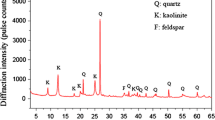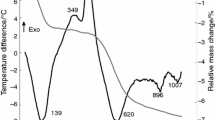Conclusions
The appearance of anomalies on the viscosity curve is due to physical-chemical processes occurring during the firing of refractory clays. By using the viscosity curve for a refractory clay it is possible to determine the temperature at which the neogenes being to appear and complete their appearance. The temperature minimum on the viscosity curve corresponds to the commencement of the appearance of the crystalline neogenes and at the maximum temperature the process is complete.
Refractory clays are inclined to swell. This begins after the anomalies on the viscosity curve.
Similar content being viewed by others
References
N. V. Solomin. Refractories in glass industry. Promstroyizdat, 1949.
I. Ya. Zalkind and others. Coll. “Experimental Adjustment Work by ORGRES”. Gosenergoizdat, 1950.
V. F. Pavlov and other. Proc. Stroykeramika Research Institute, Issue 15, Gosstroyizdat, 1960.
E. K. Keller and other. Progress in chemistry, 1953, Vol. 22, No. 3.
Kh. O. Gevorkyan. Proc. Yerevan Polytechnical Institute, 1941, No. 1.
D. S. Belyankin and K. S. Fedot'yev [sic].
Kh. O. Gevorkyan, Izvestiya AN Armenian SSR, 1944, Nos. 5 and 6.
I. S. Kaynarskiy and others. Scientific-Engineering Information Bulletin of UNIIO, No. 4, Metallurgizdat, 1958.
Author information
Authors and Affiliations
Rights and permissions
About this article
Cite this article
Pavlov, V.F. The connection between viscosity and the physical-chemical processes occurring during refiring of refractory clays. Refractories 3, 179–181 (1962). https://doi.org/10.1007/BF01291677
Issue Date:
DOI: https://doi.org/10.1007/BF01291677




